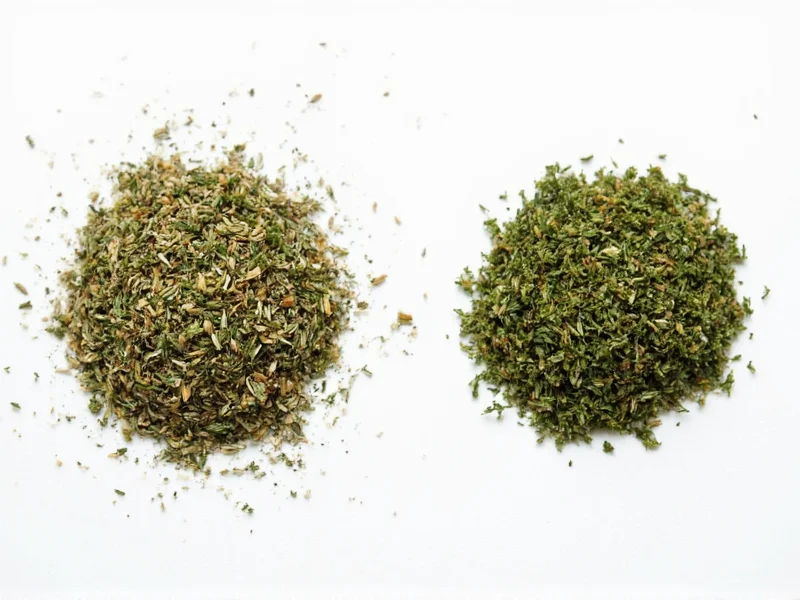Understanding herb conversions is essential for successful cooking, especially when your recipe calls for one form of thyme but you only have the other available. The 1:3 dried to fresh thyme ratio isn't arbitrary—it's based on the fundamental difference in moisture content and flavor concentration between these two forms of the same herb.
Why Dried and Fresh Thyme Have Different Measurements
When thyme undergoes the drying process, approximately 70-80% of its water content evaporates. This concentration effect means dried thyme packs significantly more flavor compounds per volume than its fresh counterpart. The essential oils that give thyme its distinctive aroma and taste become more potent as moisture disappears.
Chefs and food scientists generally agree on the 1:3 conversion ratio because it consistently produces balanced flavor in dishes. Using equal amounts would result in dried thyme overpowering your dish, while using too little would leave your recipe lacking that characteristic thyme flavor.
Thyme Conversion Chart for Practical Cooking
| Dried Thyme | Fresh Thyme Equivalent | Best Used For |
|---|---|---|
| ¼ teaspoon | ¾ teaspoon | Delicate sauces, egg dishes|
| ½ teaspoon | 1½ teaspoons | Salad dressings, light soups|
| 1 teaspoon | 1 tablespoon | Standard conversion for most recipes|
| 1½ teaspoons | 4½ teaspoons | Heartier stews, braises|
| 1 tablespoon | 3 tablespoons (¼ cup) | Large batch cooking, roasts
Adjusting the Standard Thyme Conversion Ratio
While the 1:3 ratio works for most situations, several factors might require slight adjustments to your dried thyme to fresh thyme conversion:
- Recipe cooking time: For dishes that simmer for hours (like stews), reduce dried thyme by 25% as flavors intensify over time
- Thyme variety: Lemon thyme and other specialty varieties may need slightly different ratios
- Personal preference: Some cooks prefer a more subtle herb flavor and use a 1:2.5 ratio instead
- Storage age: Older dried thyme loses potency—increase by ¼ teaspoon if your dried thyme is over a year old
Practical Tips for Substituting Thyme in Recipes
When converting between dried and fresh thyme in your cooking, consider these professional kitchen insights:
Add dried thyme early in the cooking process to allow time for rehydration and flavor distribution, while fresh thyme works best when added during the last 10-15 minutes to preserve its delicate flavor compounds. For soups and stews, tie fresh thyme sprigs with kitchen twine for easy removal after cooking.
When substituting dried for fresh in baking applications like herb breads, reduce the conversion ratio to 1:2.5 since oven heat further concentrates dried herb flavors. Always taste and adjust—your specific recipe and personal preference should guide final seasoning decisions.
How Thyme Compares to Other Common Herb Conversions
While the dried to fresh thyme conversion follows the standard 1:3 ratio, other herbs have slightly different requirements:
- Basil: 1 teaspoon dried = 1 tablespoon fresh (but some prefer 1:4 due to basil's delicate nature)
- Oregano: ½ teaspoon dried = 1½ teaspoons fresh (more concentrated than thyme)
- Rosemary: ½ teaspoon dried = 1½ teaspoons fresh (similar concentration to oregano)
- Parsley: 1 teaspoon dried = 1 tablespoon fresh (but many chefs recommend using fresh whenever possible)
Unlike more delicate herbs like cilantro or dill, thyme maintains excellent flavor integrity when dried, making it one of the most reliable dried-to-fresh conversions in the herb family.
Proper Storage for Maximum Flavor Preservation
To ensure your thyme conversions remain accurate, proper storage matters:
Store dried thyme in an airtight container away from light and heat. Properly stored, it maintains peak flavor for 1-2 years. Fresh thyme lasts 1-2 weeks in the refrigerator when wrapped in a slightly damp paper towel inside a plastic bag. For longer storage, freeze fresh thyme sprigs in olive oil cubes—this method preserves flavor better than drying for certain applications.
Always check your herbs before using. Dried thyme should have a strong aroma when crushed between your fingers—if not, it's lost potency and you'll need to increase the amount slightly in your dried thyme to fresh thyme conversion.
When to Choose Dried Over Fresh Thyme
Certain cooking applications benefit from using one form over the other:
- Use dried thyme for: Long-simmering dishes, spice rubs, dry marinades, and recipes with minimal liquid
- Use fresh thyme for: Finishing dishes, salads, quick-cooking vegetables, and recipes where visual appeal matters
Understanding these applications helps you make informed decisions beyond simple measurement conversion, enhancing your overall cooking results whether you're following a traditional recipe or improvising.











 浙公网安备
33010002000092号
浙公网安备
33010002000092号 浙B2-20120091-4
浙B2-20120091-4